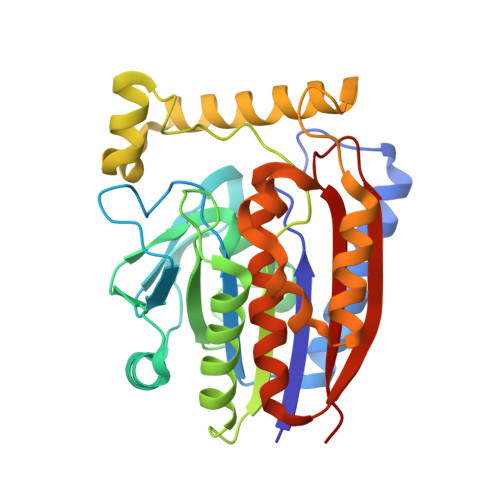| 2,3-dihydroxyphenylpropionate/2,3-dihydroxicinnamic acid 1,2-dioxygenase | | 314 | Escherichia coli | Mutation(s): 0
Gene Names: mhpB, mhpB_1, A6592_08360, AAG43_003122, ACU57_18785, AM464_18695, AT845_003692, AW119_11075, BEA19_09385, BF481_002201, BG944_000993, BGM66_001457, BJI68_13680, BJJ90_20525, BKL28_002951, BLM69_004076, BMC79_001945, BMT50_03125, BMT91_19310, BON92_03390, BTB68_001828, BUO55_000492, BvCmsKKP061_02674, BXT93_09690, BZL69_13825, C0P57_002705, C2R31_002140, C3F40_10810, C5N07_24670, C9E67_23975, CA593_01390, CDL36_14360, CDL37_09265, CG831_000406, CIG67_02690, CQ986_000779, CV83915_01226, CX938_004022, D0X26_07210, D4M65_16025, D9H94_11950, DN627_27135, DTL43_07625, DTL90_10525, DTM45_10750, DU321_19275, E4K51_23600, E5H86_16710, E6D34_13465, EA435_05985, EAN77_08135, EAX79_07015, EBP16_14625, ECs0403, EIZ93_16195, EL79_3496, ELT17_10045, ELT48_00575, ELX68_17755, ELX76_06030, ELX79_17290, EPS76_18260, ERS139208_01777, ExPECSC038_04860, F7F11_06665, F9413_17095, F9461_15720, F9S83_01345, FDM60_22665, FJQ53_15090, FKO60_15565, FOI11_011700, FOI11_08345, FPI65_01895, FV293_06300, FVB16_14265, FWK02_24950, FZU14_00995, G3565_02695, G3V95_15725, G4A38_05225, G4A47_03610, GF699_21980, GFY34_04780, GIB53_19760, GJ11_02180, GJO56_07880, GKF66_16190, GKF89_21475, GNW61_15375, GOP25_04445, GP944_04070, GP965_12675, GQM13_16935, GQM21_19370, GRC73_20955, GRW05_10415, GRW57_19650, GSM54_06355, GUI33_03835, H0O72_17150, HEP30_020365, HHH44_001337, HI055_001759, HIE29_000752, HJQ60_002399, HKA49_003062, HLV18_07550, HLX92_10820, HLZ50_17845, HMV95_12485, HV109_18305, HVY77_20140, HVZ29_04840, HX136_19710, IH772_19545, J4S20_003623, J5U05_003482, NCTC10418_05740, NCTC10429_03811, NCTC10764_05415, NCTC10974_04398, NCTC11126_05668, NCTC12950_04217, NCTC13127_05199, NCTC13148_06746, NCTC13216_02859, NCTC8179_01606, NCTC8333_04573, NCTC8450_01327, NCTC8622_02936, NCTC9044_03463, NCTC9045_04477, NCTC9073_03083, NCTC9077_04839, NCTC9111_04016, NCTC9962_02508, ND22_001410, SAMEA3472044_00503, SAMEA3472056_02987, SAMEA3751407_04552, SAMEA3752557_00177, SAMEA3753106_00568, WR15_20705
EC: 1.13.11.16
|  |
